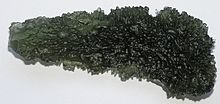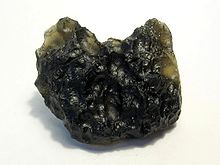Moldavite
Moldavites are green, natural glasses that were formed 15 million years ago when a large meteorite ( Ries event ) hit in what is now Bavaria , and most of them fell in the area of the Czech Republic . Such glasses produced by a meteorite impact and transported over long distances are generally called tektites , and the areas where they are found are known as stray fields . Of the four known tektite stray fields worldwide, the Moldavite find area forms the so-called Central European stray field.
Location
The Moldavites were named after the most important find area on the upper course of the Vltava river in South Bohemia (Czech Republic). Moldavites are also found in Moravia . Specimens from Bohemia are predominantly bottle green and transparent. Moravian Moldavites, on the other hand, are darker than the Bohemian ones, their color is olive green to brown, they are often used as gemstones when cut.
Moldavites have also been found sporadically in the area around Eger in western Bohemia, in the Waldviertel ( Austria ) and in Lusatia ( Germany ). These finds represent small, scattered fields that are independent of the large areas found in South Bohemia and Moravia.
Emergence
By Wolfgang Gentner (1971) by determining the age of the argon method potassium proved that the Moldavites and the so-called Ries event have the same age, namely 15 million years. It was therefore very likely that the Moldavites were formed during this event. After the prairies deposits of the Upper Freshwater Molasse (OSM) were used as the starting material by Günther Graup et al. (1981) were identified geochemically, confirmations followed by further work (cf. Johannes Baier 2007), which confirmed the connection with the Ries event.
According to today's idea, the process went as follows:
The meteorite, around 1,500 meters in diameter, entered the earth's atmosphere at around 70,000 km / h , flanked by a companion around 150 meters in diameter. The pieces hit the earth's surface almost unchecked and formed two large craters, which are now known as the Nördlinger Ries and Steinheimer Basins . When the impact occurred, the meteorites and the soil below were extremely compacted. The rock melted under high pressures and temperatures and was ejected at up to 25 times the speed of sound . During the flight, the material cooled down and solidified into glass particles . The Moldavites were hurled between 250 and 450 kilometers and mostly fell back to the ground in what is now the Czech Republic .
Chemical composition: 80% SiO 2 ; 10% Al 2 O 3 ; 3% K 2 O; 2% FeO; 2% MgO; 1.5% CaO; 0.5% Na 2 O; 0.5% TiO 2
Interesting
Moldavites were particularly popular in the Art Nouveau era, but unfortunately their fame did not last long. Their decline began with counterfeiters selling green bottle glass instead of real Czech stone. As a result, customers lost their trust in dealers. But Moldavite stepped into the limelight again when Queen Elizabeth II was ceremoniously presented with a jewelry collection from Switzerland.
One of the largest Moldavites from Bohemia was found in 1980 and weighs 142.4 grams. One of the largest Moldavites from Moravia is the Slavic Moldavite (1971), which weighs an incredible 265.5 grams.
literature
- J. Baier: On the origin and importance of the Ries ejection products for the impact mechanism . - Jber. Middle Upper Rhine. geol. Ver., N. F 01/2009; 91: 9-29.
- J. Baier: The ejection products of the Ries impact, Germany , in Documenta Naturae Vol. 162, Munich, 2007. ISBN 978-3-86544-162-1
- V. Bouška: Moldavites. The Czech Tektites. Stylizace, Prague 1994
- W. Gentner: Cogenesis of the Ries crater and moldavites and the origin of tektites . Meteoritics 6, 274, 1971.
- G. Graup, P. Horn, H. Köhler & D. Müller-Sohnius: Source material for moldavites and bentonites. In science. Vol. 67, Berlin, 1981.
- Guy Heinen: Tektite - Witnesses of Cosmic Disasters. Self-published, Luxembourg, 1997 [1]
- Christian Pinter: It's raining glass - the coveted Moldavites are evidence of cosmic catastrophes , in: Extra (weekend supplement to the Wiener Zeitung), April 24, 1998, page 5
- Trnka, M. & Houzar, S. (2002): Moldavites: a review (PDF; 389 kB). Bulletin of the Czech Geological Survey, 77, 283-302.
Web links
Individual evidence
- ↑ Moldavite: the mysterious gem from the Czech Republic. Retrieved November 11, 2019 .

